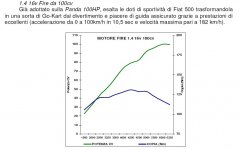I would agree the ECU mapping is different, especial in sport mode, the 100HP dose have lower gear ratios and better standard tyres so a little of each could be the reason.
I don't think the mapping changes in sport mode, rather it is just the responsiveness of the throttle. Shorter gear ratios in the 100hp would certainly be enough to make the difference on acceleration as would grippier tyres to an extent help the car to get off the line better.
Does anyone have info on what the difference is in gear ratios?


